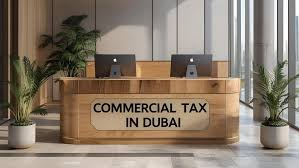Now Reading: UAE Property: 7 Key Tax Rules for Commercial Asset Owners in 2025
-
01
UAE Property: 7 Key Tax Rules for Commercial Asset Owners in 2025
UAE Property: 7 Key Tax Rules for Commercial Asset Owners in 2025

Table of Contents
The UAE’s real estate market, Property valued at AED 958 billion in 2024 with 23.9% year-on-year growth, offers commercial asset owners 6–9% yields in prime areas like Dubai Marina and Sheikh Zayed Road, per gtlaw.com.
The 9% corporate tax (CT) introduced in June 2023 under Federal Decree-Law No. 47, alongside 5% VAT and emirate-specific fees, significantly impacts commercial property owners, with non-compliance fines up to AED 500,000, per jaxaauditors.com.
Understanding key tax rules is critical for optimizing returns. This article outlines seven key tax rules for UAE commercial asset owners in 2025, with U.S. investor considerations, using web insights.
UAE Tax Framework for Commercial Asset Owners
Commercial asset owners face the following tax considerations, per czta.ae:
- Corporate Tax: 9% on profits above AED 375,000 (~$102,000); 0% for Qualifying Free Zone Persons (QFZPs) or small businesses with revenue below AED 3 million until December 31, 2026, per taxsummaries.pwc.com.
- VAT: 5% on commercial transactions (e.g., office leases, retail sales); residential leases are exempt, per shuraatax.com.
- Transfer Fees: 4% in Dubai (split 2% buyer/seller); 2% in Abu Dhabi, per providentestate.com.
- Deductions and Exemptions: Business expenses are deductible; certain structures (e.g., REITs, QFZPs) offer CT exemptions, per mosaicchambers.com.
- Compliance: Federal Tax Authority (FTA) registration, seven-year record retention, and EmaraTax filings are mandatory, per hawksford.com.
7 Key Tax Rules for Commercial Asset Owners in 2025

1. Mandatory VAT on Commercial Leases
Commercial leases (e.g., offices, retail spaces) are subject to 5% VAT, which owners must charge and remit to the FTA, per shuraatax.com. Non-compliance risks fines up to AED 50,000.
- Impact: A AED 2 million (~$544,000) annual lease generates AED 100,000 VAT liability, reducing net yield by 0.2% on a AED 50 million property if not passed to tenants.
- U.S. Consideration: No U.S. VAT impact; report income on Form 1120-F, per irs.gov.
- Action: Register for VAT; issue compliant invoices; file returns via EmaraTax, per finanshels.com.
2. Corporate Tax on Rental Income
Commercial rental income above AED 375,000 (~$102,000) is subject to 9% CT for corporate owners, unless exempt (e.g., QFZPs), per taxsummaries.pwc.com. Individuals face 0% personal income tax.
- Impact: A company with AED 3 million (~$816,000) rental income pays AED 247,500 CT (9% on AED 2.625 million), reducing yield by 0.5% on a AED 50 million property.
- U.S. Consideration: Report on Form 1120-F; claim Foreign Tax Credit (Form 1116) for UAE CT, per irs.gov.
- Action: Calculate taxable income; file CT returns; retain records, per hawksford.com.
3. Deductible Operating Expenses
Expenses like property management, maintenance, utilities, and marketing for commercial properties are deductible from taxable income, reducing CT liability, per proactfs.com.
- Impact: A company with AED 2 million (
$544,000) rental income and AED 600,000 ($163,000) expenses pays AED 126,000 CT (9% on AED 1.4 million), saving AED 54,000. - U.S. Consideration: Deduct expenses on Schedule E; report on Form 1120-F, per irs.gov.
- Action: Retain invoices; use accounting software (e.g., QuickBooks); file with FTA, per farahatco.com.
4. QFZP Status for Free Zone Owners

Commercial assets in Free Zones (e.g., DIFC, DMCC) can qualify for 0% CT as QFZPs if substance requirements (e.g., local office, staff) are met, per pwc.com. Non-qualifying income (e.g., mainland leases) faces 9% CT.
- Impact: A QFZP with AED 3 million (~$816,000) rental income saves AED 270,000 CT, preserving 8% yield on a AED 37.5 million property.
- U.S. Consideration: Report income on Form 1120-F; disclose assets on Form 8938, per irs.gov.
- Action: Register in DIFC; ensure FTA compliance; monitor non-qualifying income, per emirabiz.com.
5. Loss Carryforward for Commercial Losses
Corporate owners can carry forward losses indefinitely to offset future taxable income, provided shareholder ownership remains at least 50% stable, per taxsummaries.pwc.com. This aids properties with initial losses.
- Impact: A AED 1 million (~$272,000) loss in 2024 offsets AED 1 million profit in 2025, saving AED 90,000 CT, maintaining 8% yield.
- U.S. Consideration: Report losses on Form 1120-F; align with IRS loss carryforward rules, per irs.gov.
- Action: Document losses; file CT returns via EmaraTax; retain records, per hawksford.com.
6. REIT Exemptions for Commercial Portfolios
Real Estate Investment Trusts (REITs) in DIFC or ADGM holding commercial assets are exempt from CT if they distribute 90% of profits and meet FTA criteria, per mosaicchambers.com.
- Impact: A REIT with AED 5 million (~$1.36 million) income saves AED 450,000 CT, boosting yield by 0.9% on a AED 50 million portfolio.
- U.S. Consideration: Report distributions on Form 1040; disclose on Form 8938, per irs.gov.
- Action: Structure REIT with DIFC; ensure compliance; audit governance, per knightsbridge.ae.
7. Interest Deduction on Commercial Loans
Interest on loans for acquiring or developing commercial properties is deductible, provided it relates to taxable income activities, per taxsummaries.pwc.com. This reduces CT liability for leveraged investments.
- Impact: A AED 2 million (~$544,000) interest payment on a AED 100 million project saves AED 180,000 CT, boosting yield by 0.2%.
- U.S. Consideration: Deduct interest on Schedule E; align with IRS Section 163, per irs.gov.
- Action: Retain loan agreements; allocate interest to projects; file with FTA, per hawksford.com.
Quantitative Impact on Returns
Consider a AED 50 million commercial property yielding 8% (AED 4 million annually):
- QFZP Status: 0% CT saves AED 360,000, maintaining 8% yield.
- Operating Expenses: AED 54,000 CT savings boosts yield to 8.1%.
- Interest Deduction: AED 180,000 CT savings raises yield to 8.4%.
- Non-Optimized Case: 9% CT (AED 360,000), 5% VAT (AED 200,000), and AED 50,000 fines reduce yield to 7.2%.
Key Considerations for U.S. Investors
- Risks:
- Non-Compliance: Fines up to AED 500,000 for tax violations, per jaxaauditors.com.
- Oversupply: 76,000 units expected in 2025–2026 may soften yields by 0.5–1%, per colife.ae.
- Costs: Compliance costs AED 10,000–20,000; legal fees AED 5,000–15,000 annually, per hausandhaus.com.
- Tax Compliance: IRS requires Form 1040, Form 1116, Form 1120-F, Form 8938, and FinCEN Form 114, per irs.gov.
- Regulatory Compliance: DLD mandates digital filings; emirate-specific fees (e.g., Dubai’s 10% municipal fee on commercial rents) apply, per crcproperty.com.
- Currency Stability: AED pegged at 1 USD = 3.67 minimizes risk, per kaizenams.com.
Conclusion
In 2025, UAE commercial asset owners must navigate seven key tax rules—VAT on leases, CT on income, deductible expenses, QFZP status, loss carryforwards, REIT exemptions, and interest deductions—to optimize 6–9% yields in a AED 958 billion market. U.S. investors, ensuring IRS and FTA compliance, can maximize returns by partnering with firms like Hawksford or Farahat & Co. for strategic tax planning. Property
read more: UAE Real Estate: 5 Tax-Free Zones Offering High Investment Returns in 2025






















